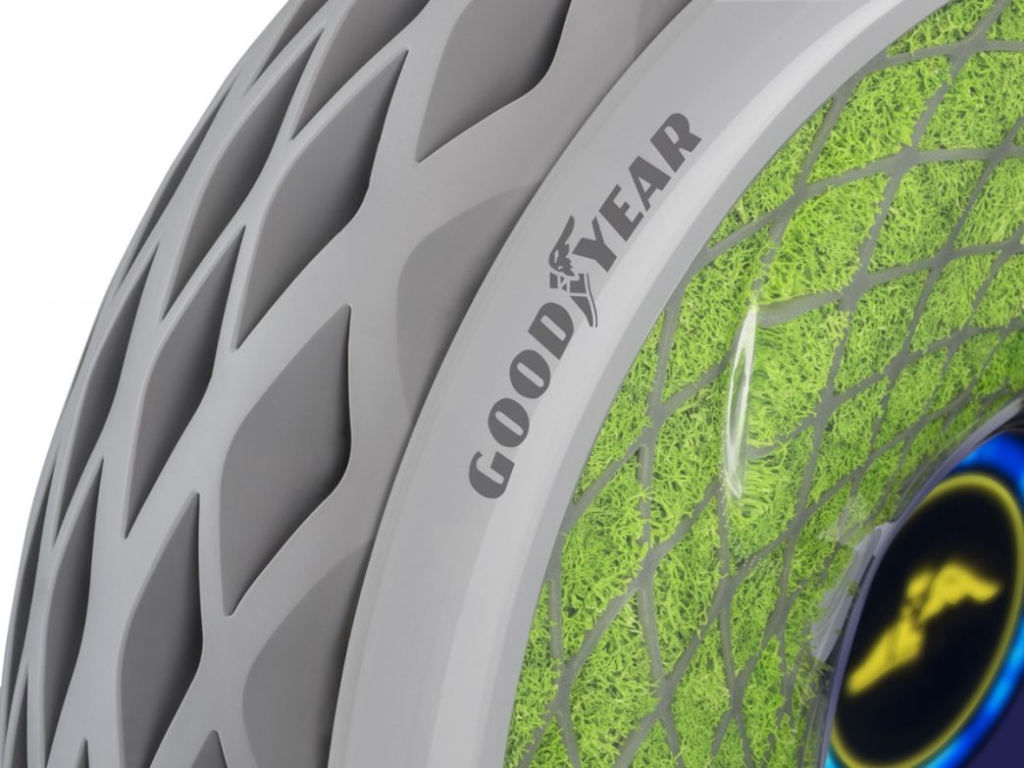Goodyear’s latest concept tire quite literally brings the future of mobility to life as a visionary solution for cleaner, more convenient, safer and more sustainable urban mobility.
The concept, named Oxygene, has a unique structure that features living moss growing within the sidewall. This open structure and the tire’s smart tread design absorb and circulate moisture and water from the road surface, allowing photosynthesis to occur and therefore releasing oxygen into the air.
According to the World Health Organization (WHO) more than 80 percent of people who live in air pollution-measured urban areas are exposed to air quality levels that exceed WHO limits.
“With more than two-thirds of the world population expected to live in cities by 2050, the demands on transport networks in urban environments will increase substantially,” said Chris Delaney, President of Goodyear Europe, Middle East and Africa. “Smarter, greener infrastructure and transport will be crucial in addressing the most pressing challenges of urban mobility and development.”

Inspired by the principles of the circular economy, with emphasis on reducing material waste, emissions, and energy loss, Goodyear’s Oxygene concept is designed to integrate seamlessly into future cityscapes, featuring several performance solutions:
Cleaning the Air We Breathe: Oxygene absorbs moisture from the road through its unique tread and inhales CO2 from the air to feed the moss in its sidewall and release oxygen via photosynthesis. In a city similar in size to greater Paris with about 2.5 million vehicles, this would mean generating nearly 3,000 tons of oxygen and absorbing more than 4,000 tons of carbon dioxide per year.
Recycling Worn Tires: Oxygene features a non-pneumatic construction that is 3D-printed with rubber powder from recycled tires. The lightweight, shock-absorbing structure provides a long-lasting, puncture-free solution intended to extend the life of the tire and minimize service issues, delivering worry-free mobility. Additional safety is ensured by the tire’s open structure, which improves wet grip by helping absorb water from the tread.
Generating its Own Electricity: Oxygene harvests the energy generated during photosynthesis to power its embedded electronics, including onboard sensors, an artificial intelligence processing unit, and a customizable light strip in the tire’s sidewall that switches colors, warning both road users and pedestrians of upcoming maneuvers, such as lane changes or braking.
Communicating at the Speed of Light: Oxygene uses a visible light communications system, or LiFi, for high-capacity mobile connectivity at the speed of light. LiFi enables the tire to connect to the Internet of Things, allowing vehicle-to-vehicle (V2V) and vehicle-to-infrastructure (V2I) data exchange, which is critical to smart mobility management systems.
“Like the concept designs Goodyear has presented at Geneva in the past, Oxygene is meant to challenge our thinking and help drive the debate around smart, safe and sustainable future mobility,” Delaney said. “By contributing in this way to cleaner air generation, the tire could help enhance quality of life and health for city-dwellers.”
Credit : Goodyear
https://corporate.goodyear.com/us/en.html
Additionally the understanding is;
The tire, called Oxygene, has living moss growing within its sidewall. It features an open structure that allows air to circulate, as well as a smart tread design that lets the tire absorb and circulate moisture from the road, enabling photosynthesis to occur and oxygen to be released. In a city similar in size to metropolitan Paris, with about 2.5 million vehicles, this would mean generating nearly 3,000 tons of oxygen and absorbing more than 4,000 tons of carbon dioxide per year.
The tire also generates its own electricity, harvesting the energy generated by photosynthesis to power its embedded electronics, which include an artificial intelligence processing unit, onboard sensors, and a customizable light strip in the tire’s sidewall that changes colors, warning other drivers and pedestrians of impending lane changes or braking. That’s not all in terms of high tech features, though – Oxygene uses a visible light communications system, or LiFi, for high capacity mobile connectivity at the speed of light. LiFi allows the tire to connect to the Internet of Things, allowing vehicle-to-vehicle (V2V) and vehicle-to-infrastructure (V2I) data exchange.
